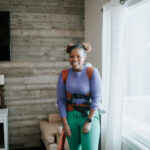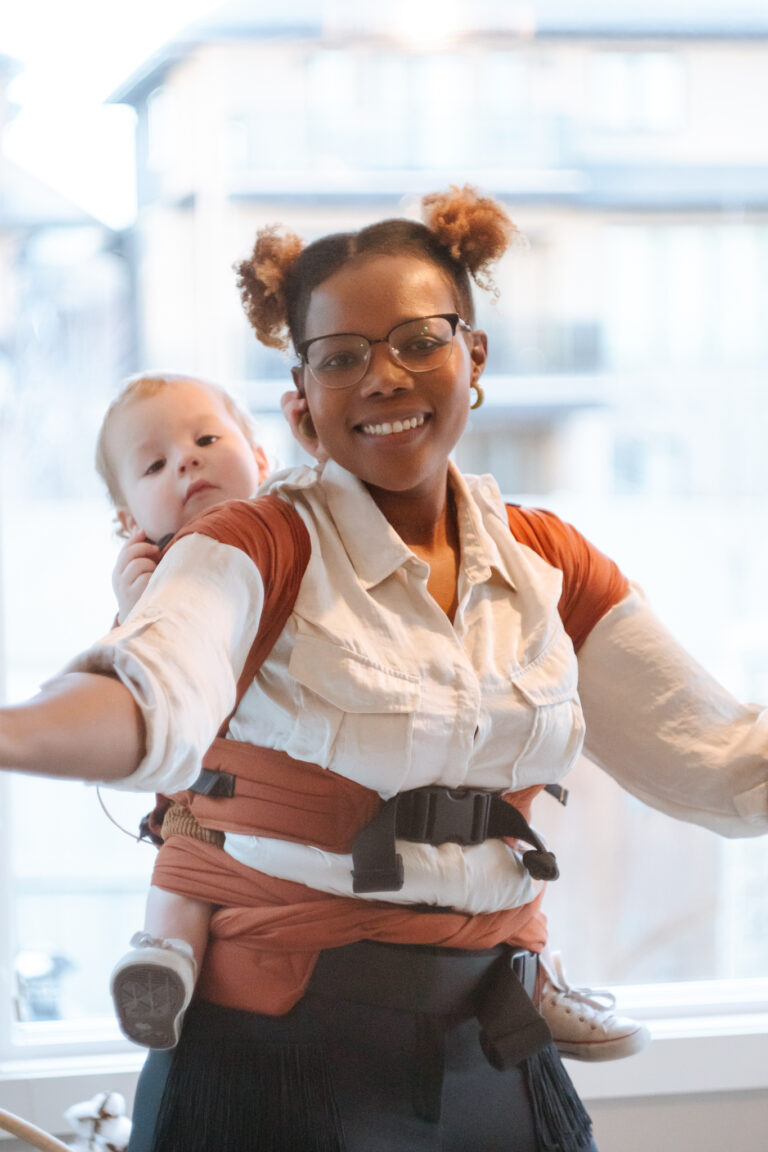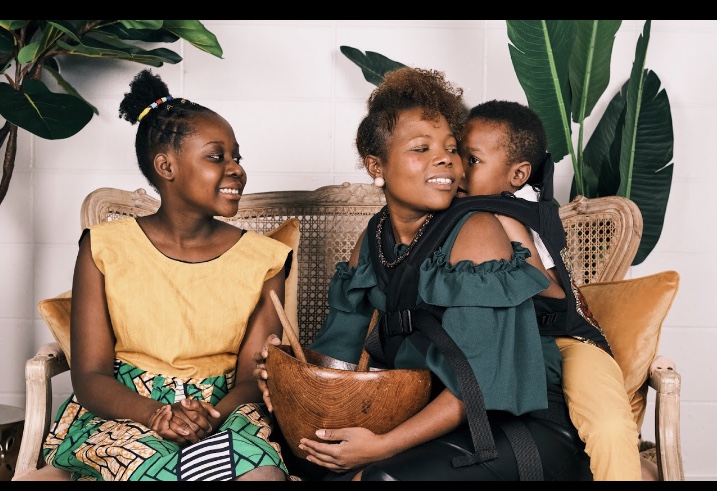Introduction
When I invited Busi, founder of BabueBaby, to share her perspective, she responded with insights that beautifully merge her occupational therapy training and her upbringing in Zimbabwe, where carrying babies is a cultural norm.
Her written responses highlighted something profound. For generations, caregivers around the world have carried babies in ways that support development, regulation, and bonding. Today research helps us understand why these traditions work.
Hips: Cradling Healthy Joints
Busi explained in her response:
“At birth, the hip socket is shallow and mostly cartilage. Positioning in a carrier influences how that joint develops. Supported flexion, which means knees up, and abduction, which means spread, helps the socket form safely around the ball of the femur. Poor support, with legs pressed together or dangling, can increase risk for hip dysplasia.”
This is not just traditional wisdom but also medically supported. The International Hip Dysplasia Institute teaches that the spread squat or “M position” allows the hip to grow safely and reduces the risk of developmental dysplasia. Studies confirm that carriers which keep babies in this position provide the same healthy joint support as orthopedic harnesses.
The Spine: Respecting Natural Curves
Busi also reminded me that babies are not born with an adult shaped spine:
“Babies are born with a gentle C curve. Carriers that respect this allow the spine to gradually strengthen into the natural S shape. Over straightening or over rounding can stress the spine.”
This understanding is widely reflected in developmental therapy, where supporting a baby’s natural posture is essential for healthy motor growth.
Muscles: Work Without Strain
Busi continued:
“Supported positioning lets babies use their muscles just enough. They can work their neck, trunk, and hips while still building postural control without strain. Unsupported positions force muscles too hard or too little, slowing development.”
This point is reinforced by studies showing that inward facing carriers activate babies’ muscle systems in ways that promote balance and growth, while car seats and unsupportive devices show far less activity.

Proprioception and Comfort
What I loved in Busi’s writing is how she connected physical support with emotional wellbeing:
“Safe leg positioning also feeds the nervous system. When hips, knees, and feet are supported, babies feel secure, calm, and able to rest, freeing energy for growth and bonding.”
Science agrees. Proper sensory input through joints and muscles provides the nervous system with signals of safety, which in turn promotes calm, regulation, and learning.
Tradition Meets Science
Busi wrote:
“Long before research explained why, cultures worldwide instinctively carried babies in safe postures. Tradition has always honored the baby’s natural shape. Science now affirms what caregivers have known for centuries. The way we carry shapes the way our children grow.”
She also shared a cultural note from Zimbabwe:
“In many African traditions, babies are kept legs in for the first days of life. It is believed to continue the womb’s warmth and position, protecting the baby’s lower limbs. Their little limbs are kept tucked, warm, and safe.”
Modern science explains that this practice has real biological benefits. Babies lose heat more quickly than adults because of their higher surface area to body mass ratio and immature circulation to their feet and legs. Their bodies also cannot regulate temperature as well as ours. Keeping limbs tucked preserves warmth, protects energy, and supports growth.
Carrier Types and Safety

While tradition and science align, it is also important to recognize that carrier types vary and with them, safe positioning from birth.
The majority of buckle carriers are best utilized with legs out once the baby is ready for the carrier (many are NOT safe from birth, but there are exceptions), or with the use of an included infant pillow or insert. Using a buckle carrier without this pillow or added newborn support can significantly increase the risk of harm because it does not provide the necessary support for a newborn’s spine, hips, and airway.
Carriers like ring slings, meh dais, woven wraps, and stretchy wraps can be safely used in a legs in position, but typically only during the first days or sometimes the first weeks of life. Once a baby begins pushing up on their legs, this is a cue that their legs should be positioned out of the carrier to support their development and comfort.
This flexibility across carrier types shows how important it is to choose the right carrier for the right stage of growth, while always prioritizing positioning that protects the hips, spine, and airway.
Where Wisdom and Science Meet
As Busi wrote so beautifully:
“What our grandmothers knew in their bones, science now explains. Keeping a baby’s legs tucked and warm in those first days protects their energy, their growth, and their sense of safety.”
Her words are a reminder that we do not need to choose between cultural wisdom and modern evidence. They are two languages telling the same story.
Legs In or Legs Out?
When I asked Busi how parents can know what is best, she shared this guiding thought:
“Tradition and science agree. Babies’ needs change with their stage. Legs in or legs out, the right position is the one that protects growth, warmth, and comfort.”
Takeaway
Reading through Busi’s written responses, I was struck by how seamlessly tradition and science align. What caregivers in Zimbabwe and around the world have always done is now validated by modern studies.
For me, as both a mother and an educator, this is deeply affirming. Babywearing is not just practical. It is developmental care, it is bonding, it is cultural continuity, and it is love in action.
References
International Hip Dysplasia Institute. “Hip Healthy Swaddling and Baby Wearing.” hipdysplasia.org
Busi, BabueBaby. Written responses to interview questions, August 2025.
ResearchGate. Exploring infant hip position and muscle activity in common baby gear and orthopedic devices (2020).
Canadian Premature Babies Foundation. Neonatal Thermoregulation (2021).
World Health Organization. Thermal Protection of the Newborn: A Practical Guide (1997).
Nature Reviews Pediatrics. Thermal regulation in newborn infants: physiology and clinical relevance (2023).

